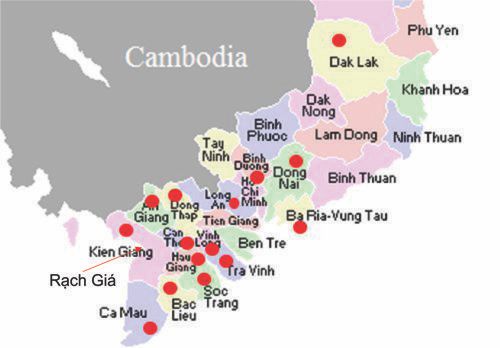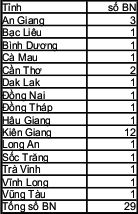 Provinces of
the patients on the pacemaker list.
Provinces of
the patients on the pacemaker list.
Patients are from practically all the southern provinces.

Dr Huynh Trung
Cang, associate director internal cardiology, Kien Giang provincial
general
hospital,
has worked with the cardiologists of all the neighboring
provinces to put together a list of 29 patients. They came from 14
provinces, as shown in the above map and the table on the right. All
patients were admitted by November 6, 2011 to the cardiology
ward. From this list of
patients, 19 (as of Nov 8, 2011) were interviewed and selected to
receive cardiac
pacemakers and CRT devices. The records of a number of patients were
still under review as on Nov 8 (the author had to leave Rach Gia on the
9th) since more data were needed to complete their evaluations, for
example 24 hour Holter reports, sonograms were still being processed.
Most of the selected patients are your typical pacemaker and CRT
patients with
sick sinus syndrome, heart block, heart failure with left bundle branch
block. But 2 patients were also selected
due to vasovagal syncopes. According to the cardiologists on the team,
these 2 patients could be treated with a drug regimen. However, in
Vietnam the
expense and the difficulty in obtaining some of these
drugs make a device based
therapy the only practical treatment option. Pacemakers with the
Biotronik CLS rate adaptation are required. Biotronik USA has
provided the team with 5 free Cylos DR premium pacemakers. In addition
to the Cylos, the CLS rate adaptation can also be found in the
Biotronik MR conditional Evia pacemakers.
 Cardiostart
pacemaker team
Cardiostart
pacemaker team
A number of patients were not selected, even though they met classical
indications. From their experiences, the team cardiologists believe
that
the lack of symptoms (mostly syncope, fatigue) would preclude any
benefit from a
pacemaker implant and may even be detrimental to the patient health,
for
example contraindication for future MRI scans (except if they have
received an MR conditional system).
Nov 7: 5 pacemaker implants ... we started late.
Nov 8: 2 CRT, 1 pacemaker. The first CRT implant was not successful due
to an unusual coronary anatomy. The patient received a dual chamber
pacemaker.
Nov 9: 5 pacemakers
Nov 10: 3 pacemakers, 1 CRT (new patient)
Nov 11: 6 pacemakers.
Thus, a total of 23 devices were implanted.
This is by far the biggest free implant mission in Vietnam
The fastest dual chamber implant took about 50 minutes from the time
the patient was wheeled into the cathlab until the final suture. In
order to reach this record time, instead of operating serially, while
measurements were made of the ventricular lead, the Vietnamese team
proceeded with implanting the atrial lead.
This mission would not have been possible without the behind the scene
tireless work of the following heroines
- Thuy-Tien Truong
- Yen Nguyen
- Tuyet Tran
Side stories.
There is a Vietnamese proverb: cooperation is a two way street. The
mission of the Cardiostart team is to pass on their pacemaker diagnosis
and implant know-how to their Vietnamese colleagues. On the flip side,
did the
Cardiostart members learn anything from their Vietnamese colleagues? Of
course!
- In the US, only rate adaptive pacemakers are implanted. One
member of the team was very surprised to learn that non rate adaptive
pacemakers do actually exist! These devices are actually priced lower
than comparable rate adaptive devices for the patients who do not need
rate adaptation.
- One of the patients has previously been implanted a
recycled
pacemaker. This is Northwest own
program
to recycle US pacemakers in Vietnam free of charge
to help poor patients.
His device now needs to be replaced. With this awareness that pacemaker
can have a second life saving poor patients in Vietnam, we hope that
they could contribute in the future.
- This happens to be the first time that the team members
learned about the composite VDD
lead. Such a lead was implanted in a patient with a good
sinus node and
with atrioventricular block. With a single lead, the patient is able to
enjoy AV synchronous pacing without taxing the implanting cardiologist
skills. This lead is available in Vietnam only
from the Biotronik distributor.
This is a technique that we have
introduced to Vietnam (english
abstract at the end of the .pdf document). Dual chamber
pacing using a single pass lead
with a recycled pacemaker is unique to Vietnam and India. The patient
only needs to buy a single lead and still enjoy dual chamber pacing!
An
appropriate vietnamese proverb: you can learn great things when you
travel
a day away from home!
- Pacemaker selection is definitely
richer in Vietnam than in the US. In a poor country like Vietnam, the
one-size fit all (well, almost all) situation in the US, with just DR
pacemakers (and a few SR pacemakers for elderly folks) avialble for
implant, is not
appropriate for Vietnam. Vietnamese
patients can choose
between the following types of pacemakers: S (single chamber, fixed
rate), SR (single chamber, rate adaptive), SLR (dual chamber, single
pass lead), D (dual chamber, fixed rate), DR (dual chamber, rate
adaptive). Patients can now also select the whole range of MR
conditional pacemakers
 that enable them to receive an MRI
scan.
that enable them to receive an MRI
scan.
- Team members are
used to implant leads with (active) screw
fixation (the top lead in the figure on the right). On this trip they
experienced implanting the 2 tined leads in the figure on the right.
The middle lead can be implanted very easily in elderly patients to
minimize procedure time.
- Vietnamese cardiologists are very persistent. In the last
case on Nov 8, the US cardiologists were giving up after many
unsuccessful attempts at implanting a left heart lead due to the
anomalous
coronary venous anatomy of the patient. The Kien Giang cardiologist
wanted to give it
a last try, and was successful in implanting the lead! Luck or skill,
we don't know. But persistence, definitely!
Just as the Vietnamese cardiologists have learned a lot from the team
members, it is our sincere hope that Cardiostart team members have had
a great experience on this mission.
On behalf of the medical staff and patients at Kien Giang Provincial
General Hospital, we would like to extend our warmest thanks to
Cardiostart and in particular to the pacemaker team, and the US
companies, Biotronik, St. Jude Medical,
Medtronic, who have made this training and humanitarian mission the
success that it has been.
Reflections of the team members
The team members
were very pleased with the eagerness to learn expressed by the medical
staff. Not only were they interested in learning implant techniques but
they were curious about the measurements made during the implant.
The
operating room was modern and the screen of the x-ray C-arm machine was
very clear. This helped made the CRT implants successful.
The cardiology ward was also well maintained and the staff took good
care of the patients.
Overall, this has been a very positive experience.
Northwest and Systolic
Medical
Products has a history of supporting training and
humanitarian projects, especially CRT related projects. Since December
2008 we have supported 4 CRT related projects. These are summarized at
our Vietnamese
CRT Training
web page. Our last project also has an
English
web page you can consult.
You can get in touch with us by e-mail at
lienlac@systolicvn.com.
We
will try to reply in the shortest time possible. Thank you for visiting
this website of Systolic Medical Products and Northwest Signal
Processing.
Visitor number: 
Last update:11/18/2011
Copyright
NWSPI 2011





 Dr Huynh Trung
Cang, associate director internal cardiology, Kien Giang provincial
general
hospital,
has worked with the cardiologists of all the neighboring
provinces to put together a list of 29 patients. They came from 14
provinces, as shown in the above map and the table on the right. All
patients were admitted by November 6, 2011 to the cardiology
ward. From this list of
patients, 19 (as of Nov 8, 2011) were interviewed and selected to
receive cardiac
pacemakers and CRT devices. The records of a number of patients were
still under review as on Nov 8 (the author had to leave Rach Gia on the
9th) since more data were needed to complete their evaluations, for
example 24 hour Holter reports, sonograms were still being processed.
Dr Huynh Trung
Cang, associate director internal cardiology, Kien Giang provincial
general
hospital,
has worked with the cardiologists of all the neighboring
provinces to put together a list of 29 patients. They came from 14
provinces, as shown in the above map and the table on the right. All
patients were admitted by November 6, 2011 to the cardiology
ward. From this list of
patients, 19 (as of Nov 8, 2011) were interviewed and selected to
receive cardiac
pacemakers and CRT devices. The records of a number of patients were
still under review as on Nov 8 (the author had to leave Rach Gia on the
9th) since more data were needed to complete their evaluations, for
example 24 hour Holter reports, sonograms were still being processed. 
 that enable them to receive an MRI
scan.
that enable them to receive an MRI
scan. 